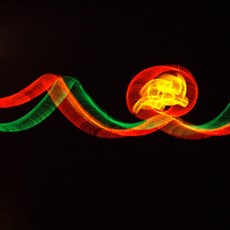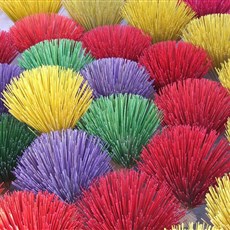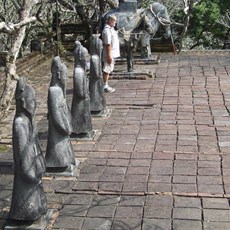2009 Biking Vietnam
We dropped out of the mountains and onto
Highway 1 which links Hanoi to Ho Chi Minh City in the south. From Ninh Binh
(pronounced Ning Bing), we took a boat ride to and through the Tam Coc caves,
and visited the Phat Diem Cathedral on a hired scooter. The coastal communities
of north Vietnam
were amongst the first to be targeted by Portuguese missionaries in the 1500s
and the population here is 95% Christian.
The cathedral, built in 1891, is a mix of Vietnamese and European architecture.
In 1951, author Graham Greene watched a battle between the French and Viet Minh
from the bell tower and used the scene in his novel, The quiet American.

Tam Coc

Tam Coc

Tam Coc

Phat Diem cathedral

Leaving Phat Diem - hammer and sickle Xmas lights
We took an overnight train south from Ninh
Binh, grateful we had opted for a “soft sleeper” compartment (the mattresses
were a stingy 5cm thick – a definite misnomer). And from Dong Ha, near the 17th
parallel which divided north Vietnam from south, we splurged on a tour to the
Truong Son cemetery (where over 10,000 graves are labeled Liet si, meaning
martyr); to the Ben Hai river (which formed the border); and to the Vinh Moc
tunnels (where 90 families from a seaside village lived on and off for several
years during US bombing; the tunnels had 14 entrances, ran for 2km, and varied from
12m to 23m in depth; seventeen babies were born underground here). Our tour
guide, conscripted to fight for South
Vietnam when just 18, spent two years in a
communist re-education camp after the war ended in 1975.

Truong Son cemetry

Ben Hai river

Vinh Moc tunnels
Vietnam’s Nguyen dynasty emperors ruled from their citadel in Hue, which is known still
for its fine cuisine. During the French colonial era, puppet emperors “reigned”
from Hue, but the real power lay in Hanoi. During the 1968
Tet Offensive, the Viet Minh took Hue
from the south / Americans and held it for over three weeks. Over 2,500
“uncooperative elements” were shot, clubbed to death or buried alive by the
communists. We visited here the Tomb of Emperor Tu Duc (who reigned for 35
years from the mid-1800s; he had 104 wives and countless concubines, but no
children; the Mandarin statues in the grounds of his tomb site were built to be
shorter than the diminutive emperor; and the 200 servants who buried him were
all beheaded to protect the location of his grave and treasures); and the Thien
Mu Pagoda (built in 1601 overlooking the Perfume River, the pagoda houses the
Austin used to transport monk Thich Quang Duc to Saigon for his 1963
self-immolation in protest of President Diem’s policies; Diem’s sister-in-law
proclaimed the event a barbecue party saying “Let them burn and we shall clap
our hands”; later that year Diem and his brother were assassinated).

Hue

Hue Tu Duc tomb

Hue Thien Mu pagoda

Hue Thien Mu pagoda

Hue Citadel